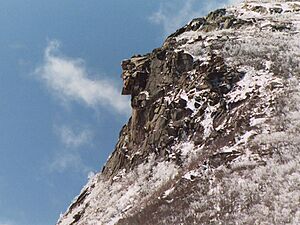Old Man of the Mountain facts for kids
The Old Man of the Mountain was a famous rock formation in New Hampshire, United States. People also called it the Great Stone Face or the Profile. It looked like the side view of a face. This natural wonder was made of five granite cliff ledges.
You could see it on Cannon Mountain in the White Mountains. The rock formation was about 1,200 feet (366 m) above Profile Lake. It was also about 40 feet (12 m) tall and 25 feet (7.6 m) wide. The Old Man was first written about in 1805. Sadly, it collapsed on May 3, 2003.
Contents
How the Old Man of the Mountain Formed
The area where the Old Man was located is called Franconia Notch. This is a U-shaped valley carved by huge sheets of ice called glaciers. After the glaciers melted about 12,000 years ago, the Old Man formation likely began to take shape.
It formed from water freezing and thawing in cracks of the hard granite rock. This process slowly broke off pieces of rock, creating the face-like shape. Surveyors working in the Franconia area first officially noted the Old Man around 1805. Francis Whitcomb and Luke Brooks were among the first to record seeing it.
Why the Old Man Was Famous
The Old Man became very well-known thanks to famous people. Daniel Webster, a statesman from New Hampshire, wrote about it. He said it was like "God Almighty has hung out a sign" in the mountains.
The writer Nathaniel Hawthorne was also inspired by the Old Man. He wrote a short story called "The Great Stone Face" in 1850. He described the formation as "a work of Nature in her mood of majestic playfulness."
The Old Man as a State Symbol
Since 1945, the Old Man's profile has been New Hampshire's state emblem. You could see it on the state's license plates and state route signs. It was also on the back of New Hampshire's Statehood Quarter. Many people said this was the only U.S. coin with a profile on both sides.
Before it collapsed, you could see the Old Man from special viewing spots. These were along Interstate 93 in Franconia Notch State Park. This park is about 80 miles (129 km) north of Concord, the state capital.
The Collapse of the Old Man
Over time, freezing and thawing water caused cracks in the Old Man's "forehead." By the 1920s, the crack was so wide that chains were used to hold it together. In 1957, the state spent money to protect it more. Workers used cement, plastic, and steel rods to try and keep it stable. They even added a concrete gutter to move water away. A team from the state worked on these repairs every summer.
Despite these efforts, the formation collapsed completely. It fell to the ground sometime between midnight and 2 a.m. on May 3, 2003. Many people were very sad about the collapse. Some even visited the site to pay their respects, leaving flowers.
After the Collapse: Remembering the Old Man
After the collapse, some people in New Hampshire wanted to build a copy of the Old Man. However, a special group led by former Governor Steve Merrill decided against this idea in 2003. In 2004, the state also thought about adding the Old Man's profile to the state flag, but this did not happen.
On the first anniversary of the collapse in May 2004, a group called the Old Man of the Mountain Legacy Fund (OMMLF) set up special viewfinders. These viewfinders are near the base of the cliff. When you look through them, you can see how the Old Man used to look before it fell.
The Old Man of the Mountain Memorial
Seven years after the collapse, on June 24, 2010, the OMMLF (now called Friends of the Old Man of the Mountain) started building a memorial. This memorial is on a walkway along Profile Lake. It includes a viewing platform with "Steel Profilers." These are special steel shapes. When you line them up with the cliff above, they create the exact profile of the Old Man.
This memorial project was completed in September 2020. It helps people remember what the Old Man of the Mountain looked like and how important it was to New Hampshire.
Timeline of the Old Man's History

- Around 12,000 years ago: Glaciers melt, and the cliff begins to form.
- 1805: Francis Whitcomb and Luke Brooks are among the first to record seeing the Old Man.
- 1832: Author Nathaniel Hawthorne visits the area.
- 1850: Hawthorne publishes "The Great Stone Face" story.
- 1869: U.S. President Ulysses S. Grant visits the formation.
- 1916: New Hampshire Governor Rolland H. Spaulding starts state efforts to protect the formation.
- 1926: The Old Man appears on New Hampshire license plates.
- 1945: The Old Man becomes the New Hampshire State Emblem.
- 1955: President Dwight D. Eisenhower visits for the Old Man's 150th "birthday."
- 1958: Major repair work is done on the Old Man's forehead.
- 1965: Niels Nielsen, a state highway worker, becomes the unofficial guardian of the profile.
- 1974-1979: The formation appears on license plate stickers.
- 1986: It becomes a crime to damage the Old Man.
- 1987: Niels Nielsen is named the official caretaker. A small image of the Old Man appears on all passenger car license plates.
- 1991: David Nielsen, Niels's son, becomes the official caretaker.
- 2000: The Old Man is featured on the New Hampshire state quarter and on new license plates.
- 2003: The Old Man collapses.
- 2004: Coin-operated viewfinders are installed to show how the Old Man looked before it fell.
- 2007: A design for an Old Man of the Mountain memorial is announced.
- 2010: The first part of the memorial is revealed.
- 2011: Profiler Plaza, part of the memorial, is dedicated.
Images for kids










